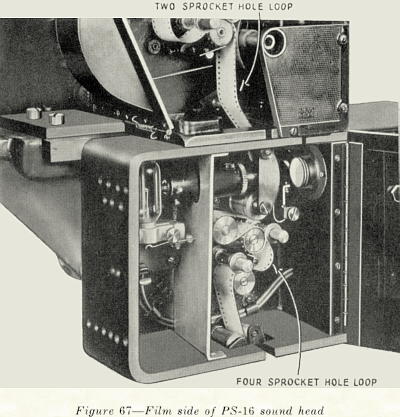99. Types PS-14 and PS-16 Sound Heads.-The PS-14 and PS-16 sound heads are used with PG-13
equipments. The PS-14 is used on Powers projectors, and the
PS-16 is used on Simplex Projectors. Figure 65 shows the location of parts in both types. The
mechanisms of these sound heads differ in many respects from those described above.
The sound gate, while similar in principle to the other gates, is considerably dif ferent in construction.
This gate is shown in Figure 66. The movable part of the gate is pivoted and the tension springs, which
are shaped like sled runners, are readily adjustable. These springs hold the film against the film guide
plate.

The viscous damping device is not used in this type of sound head but a device known as an
impedance roller is used instead. This consists of a flywheel attached to a roller about the size of a
sprocket wheel. This device is driven by the film passing over it and is not connected to the drive
mechanism in any other way. The film after leaving the sound gate passes over the roller to the
constant speed sprocket. The inertia of the roller serves to take out "wows" or "ripples" by taking out
any irregularities due to the motor drive and back lash of the gears, and causes the film to be pulled
through the gate at an absolutely constant speed. The use of the impedance roller eliminates the
necessity of a viscous damping device and makes for practically fool-proof operation.
The exciter lamp assembly differs from that used in the PS-1 sound head in that no turret is used. The
lamp socket is mounted on a bracket, is guided into the proper place by long pins, and is held in place
by friction so that the lamp and socket assembly can be removed and replaced quickly without affecting
its adjustment. A spare socket is supplied with the equipment and a spare exciter lamp should be set up
in the extra socket, focused, and set conveniently aside for emergency use.
The drive motors used are described in sections 27 and 32.
10
